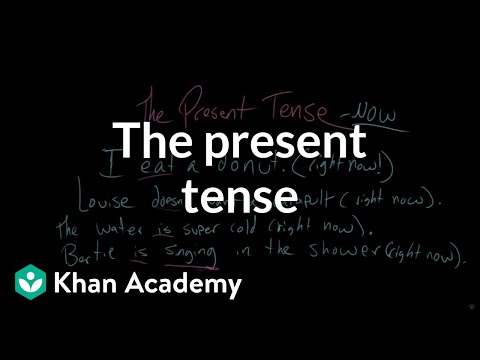7.21: Text- Verb Tenses
- Page ID
- 59200
\( \newcommand{\vecs}[1]{\overset { \scriptstyle \rightharpoonup} {\mathbf{#1}} } \)
\( \newcommand{\vecd}[1]{\overset{-\!-\!\rightharpoonup}{\vphantom{a}\smash {#1}}} \)
\( \newcommand{\id}{\mathrm{id}}\) \( \newcommand{\Span}{\mathrm{span}}\)
( \newcommand{\kernel}{\mathrm{null}\,}\) \( \newcommand{\range}{\mathrm{range}\,}\)
\( \newcommand{\RealPart}{\mathrm{Re}}\) \( \newcommand{\ImaginaryPart}{\mathrm{Im}}\)
\( \newcommand{\Argument}{\mathrm{Arg}}\) \( \newcommand{\norm}[1]{\| #1 \|}\)
\( \newcommand{\inner}[2]{\langle #1, #2 \rangle}\)
\( \newcommand{\Span}{\mathrm{span}}\)
\( \newcommand{\id}{\mathrm{id}}\)
\( \newcommand{\Span}{\mathrm{span}}\)
\( \newcommand{\kernel}{\mathrm{null}\,}\)
\( \newcommand{\range}{\mathrm{range}\,}\)
\( \newcommand{\RealPart}{\mathrm{Re}}\)
\( \newcommand{\ImaginaryPart}{\mathrm{Im}}\)
\( \newcommand{\Argument}{\mathrm{Arg}}\)
\( \newcommand{\norm}[1]{\| #1 \|}\)
\( \newcommand{\inner}[2]{\langle #1, #2 \rangle}\)
\( \newcommand{\Span}{\mathrm{span}}\) \( \newcommand{\AA}{\unicode[.8,0]{x212B}}\)
\( \newcommand{\vectorA}[1]{\vec{#1}} % arrow\)
\( \newcommand{\vectorAt}[1]{\vec{\text{#1}}} % arrow\)
\( \newcommand{\vectorB}[1]{\overset { \scriptstyle \rightharpoonup} {\mathbf{#1}} } \)
\( \newcommand{\vectorC}[1]{\textbf{#1}} \)
\( \newcommand{\vectorD}[1]{\overrightarrow{#1}} \)
\( \newcommand{\vectorDt}[1]{\overrightarrow{\text{#1}}} \)
\( \newcommand{\vectE}[1]{\overset{-\!-\!\rightharpoonup}{\vphantom{a}\smash{\mathbf {#1}}}} \)
\( \newcommand{\vecs}[1]{\overset { \scriptstyle \rightharpoonup} {\mathbf{#1}} } \)
\( \newcommand{\vecd}[1]{\overset{-\!-\!\rightharpoonup}{\vphantom{a}\smash {#1}}} \)
\(\newcommand{\avec}{\mathbf a}\) \(\newcommand{\bvec}{\mathbf b}\) \(\newcommand{\cvec}{\mathbf c}\) \(\newcommand{\dvec}{\mathbf d}\) \(\newcommand{\dtil}{\widetilde{\mathbf d}}\) \(\newcommand{\evec}{\mathbf e}\) \(\newcommand{\fvec}{\mathbf f}\) \(\newcommand{\nvec}{\mathbf n}\) \(\newcommand{\pvec}{\mathbf p}\) \(\newcommand{\qvec}{\mathbf q}\) \(\newcommand{\svec}{\mathbf s}\) \(\newcommand{\tvec}{\mathbf t}\) \(\newcommand{\uvec}{\mathbf u}\) \(\newcommand{\vvec}{\mathbf v}\) \(\newcommand{\wvec}{\mathbf w}\) \(\newcommand{\xvec}{\mathbf x}\) \(\newcommand{\yvec}{\mathbf y}\) \(\newcommand{\zvec}{\mathbf z}\) \(\newcommand{\rvec}{\mathbf r}\) \(\newcommand{\mvec}{\mathbf m}\) \(\newcommand{\zerovec}{\mathbf 0}\) \(\newcommand{\onevec}{\mathbf 1}\) \(\newcommand{\real}{\mathbb R}\) \(\newcommand{\twovec}[2]{\left[\begin{array}{r}#1 \\ #2 \end{array}\right]}\) \(\newcommand{\ctwovec}[2]{\left[\begin{array}{c}#1 \\ #2 \end{array}\right]}\) \(\newcommand{\threevec}[3]{\left[\begin{array}{r}#1 \\ #2 \\ #3 \end{array}\right]}\) \(\newcommand{\cthreevec}[3]{\left[\begin{array}{c}#1 \\ #2 \\ #3 \end{array}\right]}\) \(\newcommand{\fourvec}[4]{\left[\begin{array}{r}#1 \\ #2 \\ #3 \\ #4 \end{array}\right]}\) \(\newcommand{\cfourvec}[4]{\left[\begin{array}{c}#1 \\ #2 \\ #3 \\ #4 \end{array}\right]}\) \(\newcommand{\fivevec}[5]{\left[\begin{array}{r}#1 \\ #2 \\ #3 \\ #4 \\ #5 \\ \end{array}\right]}\) \(\newcommand{\cfivevec}[5]{\left[\begin{array}{c}#1 \\ #2 \\ #3 \\ #4 \\ #5 \\ \end{array}\right]}\) \(\newcommand{\mattwo}[4]{\left[\begin{array}{rr}#1 \amp #2 \\ #3 \amp #4 \\ \end{array}\right]}\) \(\newcommand{\laspan}[1]{\text{Span}\{#1\}}\) \(\newcommand{\bcal}{\cal B}\) \(\newcommand{\ccal}{\cal C}\) \(\newcommand{\scal}{\cal S}\) \(\newcommand{\wcal}{\cal W}\) \(\newcommand{\ecal}{\cal E}\) \(\newcommand{\coords}[2]{\left\{#1\right\}_{#2}}\) \(\newcommand{\gray}[1]{\color{gray}{#1}}\) \(\newcommand{\lgray}[1]{\color{lightgray}{#1}}\) \(\newcommand{\rank}{\operatorname{rank}}\) \(\newcommand{\row}{\text{Row}}\) \(\newcommand{\col}{\text{Col}}\) \(\renewcommand{\row}{\text{Row}}\) \(\newcommand{\nul}{\text{Nul}}\) \(\newcommand{\var}{\text{Var}}\) \(\newcommand{\corr}{\text{corr}}\) \(\newcommand{\len}[1]{\left|#1\right|}\) \(\newcommand{\bbar}{\overline{\bvec}}\) \(\newcommand{\bhat}{\widehat{\bvec}}\) \(\newcommand{\bperp}{\bvec^\perp}\) \(\newcommand{\xhat}{\widehat{\xvec}}\) \(\newcommand{\vhat}{\widehat{\vvec}}\) \(\newcommand{\uhat}{\widehat{\uvec}}\) \(\newcommand{\what}{\widehat{\wvec}}\) \(\newcommand{\Sighat}{\widehat{\Sigma}}\) \(\newcommand{\lt}{<}\) \(\newcommand{\gt}{>}\) \(\newcommand{\amp}{&}\) \(\definecolor{fillinmathshade}{gray}{0.9}\)What is tense? There are three standard tenses in English: past, present and future. All three of these tenses have simple and more complex forms. For now we’ll just focus on the simple present (things happening now), the simple past (things that happened before), and the simple future (things that will happen later).
Tenses
Present Tense
Watch this quick introduction to the present tense:
Past Tense
Watch this quick introduction to the past tense:
Future Tense
Watch this quick introduction to the future tense:
Other Forms of the Past, Present, and Future
You may have noticed that in the present tense video David talked about “things that are happening right now” and that he mentioned there were other ways to create the past and future tense. We won’t discuss these tenses in too much depth, but it’s important to recognize them.
We already discussed these briefly in Text: Helping Verbs. These forms are created with different forms of to be and to have:
- He had eaten everything by the time we got there.
- She is waiting for us to get there!
- He will have broken it by next Thursday, you can be sure.
- She was singing for eight hours.
When you combine to be with the –ing form of a verb you create a sense of continuity. The subject of the sentence was (or is, or will be) doing that thing for awhile. When you combine to have with the past participle of a verb, you create a sense of completion. This thing had been done for a while (or has been, or will have been). The sense of past, present, or future comes from the conjugation of to be or to have. For further discussion on this topic, look at the “Participles” section in Text: Non-Finite Verbs.
Conjugation
Most verbs will follow the pattern that we just learned in the previous videos:
| Person | Past | Present | Future |
| I | verb + ed | verb | will verb |
| We | verb + ed | verb | will verb |
| You | verb + ed | verb | will verb |
| He, She, It | verb + ed | verb + s (or es) | will verb |
| They | verb + ed | verb | will verb |
To Walk
Let’s look at the verb to walk for an example:
| Person | Past | Present | Future |
| I | walked | walk | will walk |
| We | walked | walk | will walk |
| You | walked | walk | will walk |
| He, She, It | walked | walks | will walk |
| They | walked | walk | will walk |
Practice
Change the tense of each sentence as directed below. You can type your answers in the text field below:
- Make this sentence present tense: Alejandra directed a play.
- Make this sentence past tense: Lena will show me how to use a microscope.
- Make this sentence future tense: Gabrielly eats a lot of hamburgers.
[practice-area rows=”4″][/practice-area]
[reveal-answer q=”474777″]Click to Show Answer[/reveal-answer]
[hidden-answer a=”474777″]
- Alejandra directs a play.
- Lena showed me how to use a microscope.
- Gabrielly will eat a lot of hamburgers.
[/hidden-answer]
Irregular Verbs
There are a lot of irregular verbs. Unfortunately, there’s a lot of memorization involved in keeping them straight. This video shows a few of the irregular verbs you’ll have to use the most often (to be, to have, to do, and to say):
- Text: Verb Tenses. Provided by: Lumen Learning. License: CC BY: Attribution
- The present tense. Authored by: David Rheinstrom. Provided by: Khan Academy. Located at: https://www.khanacademy.org/humanities/grammar/partsofspeech/grammar-verbs/v/present-tense-verbs-the-parts-of-speech. License: CC BY-NC-SA: Attribution-NonCommercial-ShareAlike
- The past tense. Authored by: David Rheinstrom. Provided by: Khan Academy. Located at: https://www.khanacademy.org/humanities/grammar/partsofspeech/grammar-verbs/v/the-past-tense-verbs-the-parts-of-speech. License: CC BY-NC-SA: Attribution-NonCommercial-ShareAlike
- The future tense. Authored by: David Rheinstrom. Provided by: Khan Academy. Located at: https://www.khanacademy.org/humanities/grammar/partsofspeech/grammar-verbs/v/the-future-tense-verbs-the-parts-of-speech. License: CC BY-NC-SA: Attribution-NonCommercial-ShareAlike
- Introduction to irregular verbs. Authored by: David Rheinstrom. Provided by: Khan Academy. Located at: https://www.khanacademy.org/humanities/grammar/partsofspeech/grammar-verbs/v/introduction-to-irregular-verbs-the-parts-of-speech-grammar. License: CC BY-NC-SA: Attribution-NonCommercial-ShareAlike





